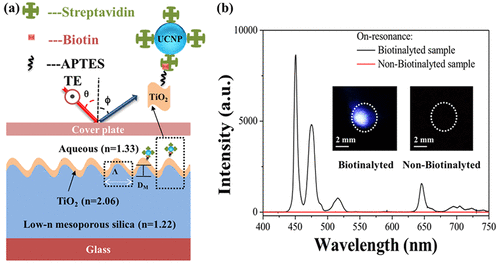当前位置:
X-MOL 学术
›
ACS Photonics
›
论文详情
Our official English website, www.x-mol.net, welcomes your
feedback! (Note: you will need to create a separate account there.)
Enhancing Upconversion Luminescence Emission of Rare Earth Nanophosphors in Aqueous Solution with Thousands Fold Enhancement Factor by Low Refractive Index Resonant Waveguide Grating
ACS Photonics ( IF 6.5 ) Pub Date : 2018-05-14 00:00:00 , DOI: 10.1021/acsphotonics.8b00494 Duc Tu Vu,Hsien-Wen Chiu,Robasa Nababan,Quoc Minh Le,Shiao-Wei Kuo,Lai-Kwan Chau,Chu-Chi Ting,Hung-Chih Kan,Chia-Chen Hsu
ACS Photonics ( IF 6.5 ) Pub Date : 2018-05-14 00:00:00 , DOI: 10.1021/acsphotonics.8b00494 Duc Tu Vu,Hsien-Wen Chiu,Robasa Nababan,Quoc Minh Le,Shiao-Wei Kuo,Lai-Kwan Chau,Chu-Chi Ting,Hung-Chih Kan,Chia-Chen Hsu

|
The enhancement of upconversion luminescence (UCL) of rare earth doped upconversion nanoparticles (UCNPs) in aqueous solution is particularly important and urgently required for a broad range of biomedical applications. Herein, an effective approach to achieve highly enhanced UCL from NaYF4:Yb3+,Tm3+ UCNPs in aqueous solution is presented. We demonstrate that UCL of these UCNPs can be enhanced more than 104-fold by using a mesoporous silica low refractive index resonant waveguide grating (low-n RWG) in contact with aqueous solution, which makes it well-suited for biomedical applications. The structure parameters of the low-n RWG are tuned via rigorous coupled-wave analysis simulation to ensure strong local excitation field to form atop the TiO2 surface of the low-n RWG, where UCNPs are deposited. As the low-n RWG is excited by a near-infrared laser at 976 nm to match its guided mode resonance (GMR) condition, UCL emitted from UCNPs is greatly enhanced thanks to the strong interaction between excitation local field and UCNPs. UCL emission of UCNPs can be further enhanced about two to four times when the UCL emission condition (wavelength and angle) matches with the GMR condition. Furthermore, we show that the presence of biotin molecules atop of the low-n RWG can be easily detected through UCL emission generated from streptavidin-functionalized UCNPs with the help of the streptavidin–biotin specific binding. The results indicate that the low-n RWG has high potential for UCL biosensing and bioimaging applications.
中文翻译:

低折射率共振波导光栅提高倍数增强因子的水溶液中稀土纳米磷光体的上转换发光
水溶液中稀土掺杂的上转换纳米粒子(UCNPs)的上转换发光(UCL)的增强特别重要,并且在广泛的生物医学应用中迫切需要。在本文中,提出了一种从水溶液中的NaYF 4:Yb 3+,Tm 3+ UCNPs高度增强UCL的有效方法。我们证明这些UCNP的UCL可以增强10 4以上通过使用介孔二氧化硅低折射率共振波导光栅(低n RWG)与水溶液接触,实现了三倍折叠,这使其非常适合生物医学应用。低n RWG的结构参数通过严格的耦合波分析仿真进行了调整,以确保在TiO 2顶部形成强大的局部激发场低n RWG的表面,其中沉积了UCNP。由于低n RWG被976 nm的近红外激光激发以匹配其导模共振(GMR)条件,由于激发局部场和UCNP之间的强相互作用,大大增强了UCNP发出的UCL。当UCL发射条件(波长和角度)与GMR条件匹配时,UCNPs的UCL发射可以进一步提高约2-4倍。此外,我们表明在链霉亲和素-生物素特异性结合的帮助下,通过链霉亲和素功能化的UCNPs产生的UCL发射可以很容易地检测出低n RWG上方的生物素分子的存在。结果表明,低n RWG在UCL生物传感和生物成像应用中具有很高的潜力。
更新日期:2018-05-14
中文翻译:

低折射率共振波导光栅提高倍数增强因子的水溶液中稀土纳米磷光体的上转换发光
水溶液中稀土掺杂的上转换纳米粒子(UCNPs)的上转换发光(UCL)的增强特别重要,并且在广泛的生物医学应用中迫切需要。在本文中,提出了一种从水溶液中的NaYF 4:Yb 3+,Tm 3+ UCNPs高度增强UCL的有效方法。我们证明这些UCNP的UCL可以增强10 4以上通过使用介孔二氧化硅低折射率共振波导光栅(低n RWG)与水溶液接触,实现了三倍折叠,这使其非常适合生物医学应用。低n RWG的结构参数通过严格的耦合波分析仿真进行了调整,以确保在TiO 2顶部形成强大的局部激发场低n RWG的表面,其中沉积了UCNP。由于低n RWG被976 nm的近红外激光激发以匹配其导模共振(GMR)条件,由于激发局部场和UCNP之间的强相互作用,大大增强了UCNP发出的UCL。当UCL发射条件(波长和角度)与GMR条件匹配时,UCNPs的UCL发射可以进一步提高约2-4倍。此外,我们表明在链霉亲和素-生物素特异性结合的帮助下,通过链霉亲和素功能化的UCNPs产生的UCL发射可以很容易地检测出低n RWG上方的生物素分子的存在。结果表明,低n RWG在UCL生物传感和生物成像应用中具有很高的潜力。


















































 京公网安备 11010802027423号
京公网安备 11010802027423号